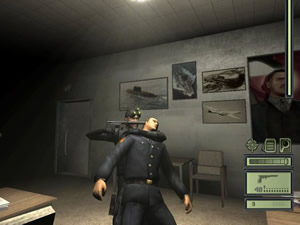Splinter Sold!
A hapless guard goes about his routine patrol. You load your modular rifle with
a projectile noisemaker and fire it at a wall, in a corner, obscured by shadows.
You could be hiding there, but you are not. You are in a flower pot, unseen. You
are deadly! You set off the noise maker and startle the guard. He runs to the
source of the sound, only to find it a source of noxious gas! He staggers, clutches
his throat, gasps for air but only comes up with your terrible poison. He falls.
You have struck again.
Quiet
as the owl. Cunning as the fox. Silent. Unseen. Deadly. You are a Splinter Cell.
In the PC version of Ubi Soft’s Splinter Cell, you become Sam Fisher
– Fly On The Wall Extraordinaire! It’s your duty to crawl, climb, rappel, and
headshot your way into the depths of enemy intelligence to solve the mystery
of two missing operatives, and maybe even prevent World War III. If this sounds
similar to the acclaimed Xbox
version of Splinter Cell, it should. In fact, the two games are basically
identical, with the exception of improved saving options.
The overall arc of the game is still linear, as are the objectives. Do this to get there. Kill him, and receive further orders. Kill them and the mission is over. However, Sam, bad-ass man of espionage and reconnaissance that he is, has lots of tools and abilities that present several choices in how he accomplishes objectives. The game is like a puzzle this way.
For example, at one point you have to grab an enemy commander and make him
open a door for you. However, this task is made difficult by several factors,
not the least of which is the fact that he’s constantly moving and alert. I
found that the best way to get him was to leave bodies in a place where he was
sure to find them. Upon encountering his fallen friends, he would try to revive
them, and that’s when I’d make my move. Subtle as a serpent, I would strike,
and force the officer to do my bidding, after which I’d discard his useless
corpse in the shadows.
However, I didn’t come to this conclusion on my first try. Or on my third or fourth. This is why the ability to quicksave is so helpful and so much better than the checkpoint system in the Xbox version. Splinter Cell is a tricky game, and difficult even with quicksaves (especially since you can quicksave yourself into a hole and not be able to get back out).
Splinter Cell‘s gameplay is perfectly adapted to the mouse and keyboard.
You move using the W, S, A, and D keys and use a context-sensitive display panel
to perform most of Sam’s more specific actions, like grabbing a baddy or opening
a door. You can still perform the wall-jump and the split jump, grab guys and
use them as human shields, hang off ledges, climb lattices, and shimmy hand-over-hand
along wires. And you can even do all this while shooting! Talk about covering
the bases.
 Running,
Running,
walking and sneaking are effectively manipulated via the mouse-wheel, one click
of which will take your speed up or down one notch, and is another example of
how intuitively every aspect of the play mechanics transfers to the PC version.
Otherwise, all gameplay elements are identical to the Xbox version, such as
creeping around and watching your shadow-meter as you attempt to stay concealed
from enemy eyes, not to mention the cool gadgets (lock-picks, cameras, noisemakers,
grenades, etc.)
However, the graphics, which were breathtaking on the Xbox, aren’t as impressive
in a PC context. They are still marvelous, but the beauty of Splinter Cell
lies more in creative use of light and shadow than having smoother edges or
finer textures. This isn’t to say that Splinter Cell looks bad, because
it certainly does not. It’s just that the credit is due more to the developers’
artistic propensities and not the game engine (even though the animation is
as smooth as 007, and certain effects, such as night-vision, are so realistic
it’s uncanny).
The sounds are also done well, with different effects for different floor
surfaces and slight aural details which become noticeable the faster Sam moves.
All of the voices are clear and well-rendered and the acting is fine. It would
have been nice, though, if lines could have been delivered in their original
language and then subtitled.
If you grow bored with twitch-action mayhem, rocket launchers and the dumbest
enemies ever, then you may want to step into Sam Fisher’s quiet and quite menacing
shoes. Likewise, if you enjoy the notion of taunting your hapless victims from
the shadow and weep every time Buffalo Bill puts on his night-vision goggles
in The Silence of the Lambs, you too should definitely give this game
a gander. And finally, if you just like video games and own a good PC, then
pick this up, don the black duds of Sam Fisher, and instantly become a fan of
the stealth/adventure genre.

-
Fun!
-
Great scenarios
-
Awesome atmosphere
-
Quicksaves
-
Looks killer
-
But just a little rough around the edges
-
Still too linear / limited replay







